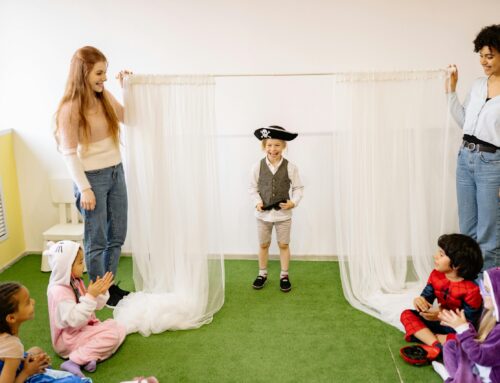Book Week is the perfect time to spark a love for storytelling with children, inviting them into the delightful world of short story writing. Engaging children in writing can be a joyful experience, especially when parents, teachers, and librarians work together to nurture their imaginative minds. Whether you’re in a classroom or at home in Moranbah, QLD, storytelling with children offers a fun and rewarding way to celebrate Book Week activities. This guide will help you create wonderful stories with your little ones, turning their creative ideas into captivating tales. Join us as we explore the simple steps to inspire children’s creative writing and make this Book Week unforgettable for the young storytellers in your life.
Setting the Stage for Storytelling
Before diving into short story writing with children, it’s important to create an environment that nurtures creativity and imagination. Let’s explore how to set up a space that inspires young minds and choose themes that spark their interest.
Creating a Welcoming Environment
To engage children in writing, the first step is to create a welcoming space that encourages creativity. A comfortable and inviting area can make a big difference in how children approach storytelling.
Start by choosing a quiet corner in your home or classroom where children can focus without distractions. Add soft cushions, bean bags, or a cosy rug to make the space feel special and relaxing.
Good lighting is crucial for writing, so ensure the area is well-lit, preferably with natural light. If possible, set up a small table or desk where children can spread out their writing materials.
Decorate the space with inspiring elements like colourful posters of book covers, quotes from favourite authors, or even the children’s own artwork. This personal touch can make the writing area feel more inviting and spark creativity.
Simply Sunshine suggests that “a carefully prepared environment can inspire children’s natural curiosity and desire to learn.” This principle applies perfectly to creating a space for storytelling.
Choosing a Fun Theme
Selecting an exciting theme can really boost children’s enthusiasm for short story writing. The right topic can spark their imagination and make the writing process more enjoyable.
Consider the interests of the children you’re working with. Are they fascinated by space, animals, or fairy tales? Use these interests as a starting point for your theme.
You can also tie the theme to current events or the season. For example, during Book Week, you might choose a theme related to favourite book characters or genres.
Present the theme in a fun way, perhaps through a colourful poster or by dressing up. This visual representation can help children connect with the theme and start generating ideas for their stories.
Remember, the goal is to make writing feel like play. A fun theme can transform the task from a chore into an exciting adventure.
Engaging Children in Writing
Now that we’ve set the stage, it’s time to dive into the heart of storytelling. This section will explore how to spark children’s imagination and guide them through the process of collaborative story brainstorming.
Sparks of Imagination
Igniting a child’s imagination is key to successful short story writing. There are many ways to spark creativity and help children generate ideas for their stories.
Start with a simple prompt or question. For example, “What if you woke up and could fly?” or “Imagine you found a magical object in your backyard. What would it be?” These open-ended questions can lead to fascinating story ideas.
Use visual aids like pictures, objects, or even short video clips to inspire stories. Show children an interesting image and ask them to imagine what might be happening or what could happen next.
The National Centre for Writing suggests that “the best stories often come from a place of truth or personal experience.” This approach can help children connect more deeply with their writing.
Collaborative Story Brainstorming
Working together to create stories can be a fun and productive way to engage children in writing. Collaborative brainstorming allows children to build on each other’s ideas and learn from one another.
Start with a group discussion about possible story elements. You might use a whiteboard to list character ideas, settings, and plot points that the children suggest.
Try the “story in a bag” technique. Put various small objects in a bag and have each child pull one out. Then, work together to create a story that includes all the objects.
Encourage children to ask “what if” questions about the developing story. This can lead to unexpected and exciting plot twists that keep the narrative engaging.
Remember to value all contributions. Even seemingly silly ideas can lead to creative and entertaining stories when developed further.
Bringing Stories to Life
Once the stories are written, it’s time to bring them to life through illustration and sharing. This final stage of the process can be just as exciting and creative as the writing itself.
Illustrating Children’s Creative Writing
Adding visual elements to stories can enhance children’s engagement with their writing and help them express their ideas more fully. Illustrations can bring a new dimension to storytelling.
Encourage children to create drawings or paintings that depict key scenes from their stories. This can help them visualise their narratives more clearly and may even inspire new story elements.
For younger children, you might provide pre-drawn templates or stickers that they can use to illustrate their stories. This can make the process less daunting for those who are less confident in their drawing skills.
Consider using digital tools for illustration. Simple drawing apps on tablets can be a fun way for tech-savvy children to bring their stories to life visually.
Sharing Stories During Book Week Activities
Sharing the completed stories is a wonderful way to celebrate children’s creativity and hard work. It can also be a highlight of Book Week activities.
Organise a “story time” event where children can read their stories aloud to an audience of peers, parents, or community members. This can boost confidence and public speaking skills.
Create a display of the stories and illustrations in the classroom or library. This allows children to see their work presented professionally and gives others a chance to enjoy the stories at their own pace.
Consider compiling the stories into a class book or e-book. This can be a lasting memento of Book Week and the children’s creative efforts.
Common Sense Press notes that “sharing stories can inspire other young writers and create a supportive community of storytellers.” This sharing process can motivate children to continue writing and improving their skills.




